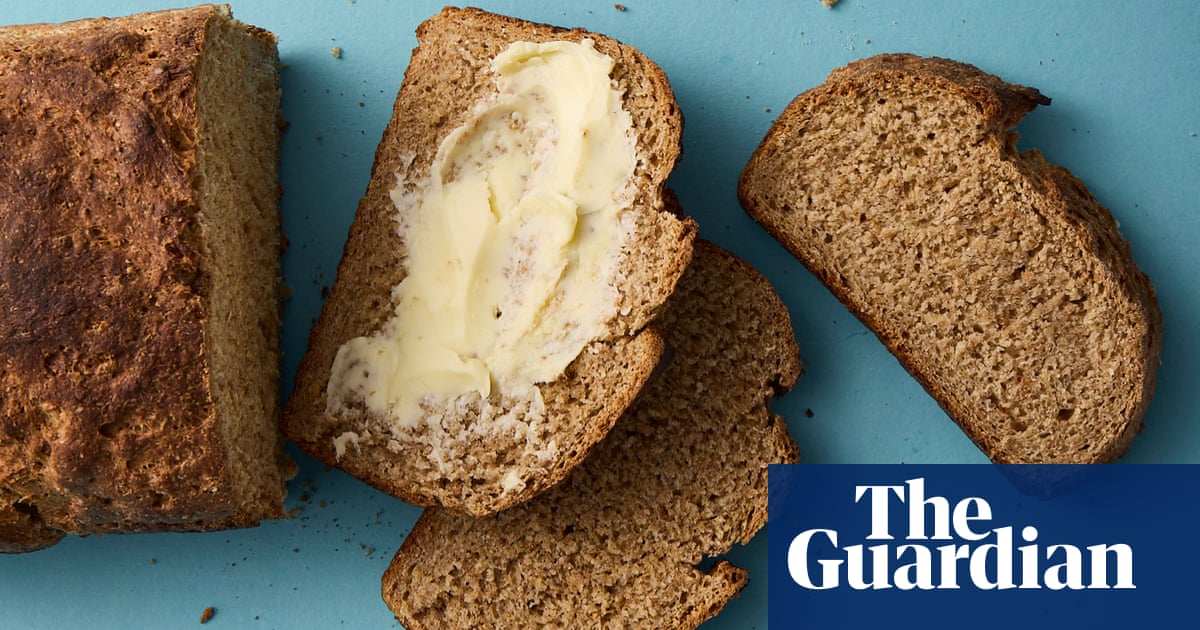I like sourdough as much as the next stereotypical Guardianista, but, despite having been on various courses in that department, I currently prefer to leave the hard work of babying bubbling starters to the professionals. If I’m going to bake bread myself, it’s either a simple, if solid, soda loaf, or this easy wholemeal one.
Prep 15 min
Prove/rest 2 hr 30 min
Cook 40 min
Makes 1
400g strong wholemeal flour
50g strong white flour
2 tsp easy-bake/fast-action yeast
2 tsp fine salt (optional)
3 tsp soft light brown sugar (optional)
50g butter
½ 500mg vitamin C tablet (optional – see step 3)
Neutral oil, for greasing
1 A note on the flour
Though diluting wholesome wholemeal flour with more refined white stuff may feel counterintuitive, doing so will give a lighter result, because white flour has more gluten (the protein that provides the structure for dough to rise in the oven). Make sure you buy strong (sometimes labelled as bread) flour in both cases, because that denotes a particularly high gluten content.
2 Mix the flours, yeast, salt and sugar
Tip both flours into a large bowl with the yeast, salt and sugar.
You can leave those last two out, if you prefer, but they do improve the flavour and, in the sugar’s case, the storage time of the bread (you can also substitute the brown sugar with white, or indeed another sweetener such as honey). Melt the butter.
3 A note on the vitamin C
Crush the half vitamin C tablet to a powder – again, this is optional, but it will help give your bread a finer, more tender crumb and a better rise – a tip I learned from the baker Dan Lepard in the Guardian more than 15 years ago. Don’t worry if you can find only fruit-flavoured tablets, either, because you won’t be able to taste it in the finished loaf. Add the vitamin C powder to the flour bowl and mix to combine.
4 Add water and melted butter, and mix
Stir in 300ml lukewarm water and the melted butter, then mix, either by hand or with the dough hook on an electric mixer, until you have a soft, sticky dough – if it feels dry, or if there’s any flour left in the bowl, very gradually add more water to remedy matters.
5 Cover and leave to rest
Once the dough is appropriately soft and sticky, cover the bowl and leave for 10 minutes (another slightly unconventional technique that I learned from the brilliant Lepard). Meanwhile, lightly grease a clean work surface with a fairly neutral oil – kneading such a soft dough on a floury surface will just make it heavy.
6 Knead and rest
Tip out the dough on to the greased surface and rub a little oil on your hands to stop it sticking to them. Fold the dough in half towards you, then push it away with the heel of your hand. Give it about a quarter turn, then repeat the fold and push motion. Do this for about 10 seconds, then put the dough back in the bowl, cover again and rest for another 10 minutes.
7 Knead and rest again
Repeat the process outlined in step 6 two more times at 10-minute intervals, then leave the dough to rest for 15 minutes. Meanwhile, lightly grease your loaf tin – annoyingly, these aren’t sold in standard sizes in the UK, but I use a 900g one (sometimes still known as a 2lb tin).
8 Shape the dough and rest again
Flatten the dough into a rough rectangle about the same length as the baking tin, then, starting from one of the long ends, roll it up tightly into a sausage and put it joint down in the tin. Cover and leave to rest in a warm place until it has doubled in height – in a UK winter, that will take at least 90 minutes.
9 Bake the loaf
Heat the oven to 240C (220C fan)/475F/gas 9, then bake the bread for 20 minutes. Turn down the oven to 220C (200C fan)/425F/gas 7 and bake for a further 15–20 minutes, until the crust is a deep brown colour and the loaf sounds hollow when you tap it. Turn out on to a rack and leave to cool completely before slicing.











